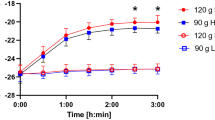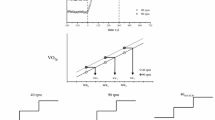Abstract
The respiratory exchange ratio (RER) is a valid method for determining fat and carbohydrate oxidation during exercise when the exchange of respiratory gas is in a state of steady flux between the tissue and fluid compartments and the alveoli. However, under incremental intensity or heavy exercise conditions, the movement of electrolytes, fluids, and CO2 between body-fluid compartments is accentuated, leading to increased hydrogen-ion concentration ([H+]), decreased bicarbonate-ion concentration ([HCO3−]) and CO2 stores, and the excretion of additional CO2 at the alveoli (i.e. H++HCO3− → CO2+H2O) elevating the CO2 minute volume. This non-respiratory CO2 excretion can invalidate use of the RER for determination of fat and carbohydrate oxidation. Direct measurement of the labile CO2 store and non-respiratory CO2 excretion during exercise is difficult. Therefore, physicochemical models were derived to illustrate the likely behaviour of compartmental CO2 stores during 8 W·min−1 incremental cycling exercise to formulate correction factors to the RER for the non-respiratory CO2 component. From these models, a polynomial regression equation was derived to describe the change in the total labile CO2 store volume during incremental exercise from the relationship with blood HCO3− content: CO2 volume (ml) = -17x2+464x+650, where x is the arterialised blood standard HCO3− concentration (mmol·l−1), relative to resting conditions. Non-respiratory CO2 excretion (ml·min−1) was then determined from the rate of change in CO2 volume. The modelling method could allow for straightforward calculation of the non-respiratory CO2 excretion rate for future validation work.








Similar content being viewed by others
References
Achten J, Gleeson M, Jeukendrup A (2002) Determination of the exercise intensity that elicits maximal fat oxidation. Med Sci Sports Exerc 34:92–97
Ahlborg G, Felig P (1982) Lactate and glucose exchange across the forearm, legs and splanchnic bed during and after prolonged exercise. J Clin Invest 69:45–54
Ahlborg G, Hagenfeldt L, Wahren J (1975) Substrate utilization by the inactive leg during one-leg or arm exercise. J Appl Physiol 39:718–723
Astrand P-O, Rodahl K (1986) Textbook of work physiology: physiological bases of exercise, 3rd edn. McGraw Hill, New York
Barstow TJ, Landlaw EM, Springer C, Cooper DM (1992) Increase in bicarbonate stores with exercise. Respir Physiol 87:231–242
Beaver WL, Wasserman K (1991) Muscle RQ and lactate accumulation from analysis of the VCO2-VO2 relationship during exercise. Clin J Sport Med 1:27–34
Chin ER, Lindinger MI, Heigenhauser GJF (1991) Lactate metabolism in inactive skeletal muscle during lactacidosis. Am J Physiol 261:R98–R105
Chin ER, Lindinger MI, Heigenhauser GJ (1997) Distribution of lactate and other ions in inactive skeletal muscle: influence of hyperkalemic lactacidosis. Can J Physiol Pharmacol 75:1375–1386
Clode M, Campball EJM (1969) The relationship between gas exchange and changes in blood lactate concentrations during exercise. Clin Sci 37:263–272
Constable PD (1997) A simplified strong ion model for acid-base equilibria: application to horse plasma. J Appl Physiol 83:297–311
Constable PD (2001) Total weak acid concentration and effective dissociation constant of nonvolatile buffers in human plasma. J Appl Physiol 91:1364–1371
Coyle EF, Coggan AR, Hopper MK, Walters TJ (1988) Determinants of endurance in well-trained cyclists. J Appl Physiol 64:2622–2630
Douglas AR, Jones NL, Reed JW (1988) Calculation of whole blood CO2 content. J Appl Physiol 65:473–7
Engeset A, Olszewski W, Jeger PM, Sokolowski J, Theodorsen L (1977) Twenty-four hour variation in flow and composition of leg lymph in normal men. Acta Physiol Scand 99:140–148
Ferrannini E (1988) The theoretical bases of indirect calorimetry: a review. Metabolism 37:287–301
Figge J, Mydosh T, Fencl V (1992) Serum protein and acid-base equilibria: a follow-up. J Lab Clin Med 120:713–719
Geers C, Gros G (2000) Carbon dioxide transport and carbonic anhydrase in blood and muscle. Physiol Rev 80:681–715
Green S, Bulow J, Saltin B (1999) Microdialysis and the measurement of muscle interstitial K+ during rest and exercise in humans. J Appl Physiol 87:460–464
Heigenhauser GJF, Jones NL, Kowalchuk JM, Lindinger MI (1990) The role of the physicochemical systems in plasma in acid-base control in exercise. In: Taylor AW, Gollnick PD, Green HJ (eds) Biochemistry of exercise VII. Human Kinetics, Champaign, Ill, pp 359–374
Hirakoba K, Maruyama A, Inaki M, Misaka K (1992) Effect of endurance training on excessive CO2 expiration due to lactate production in exercise. Eur J Appl Physiol 64:73–77
Hirakoba K, Maruyama A, Misaka K (1993) Effect of acute sodium bicarbonate ingestion on excess CO2 output during incremental exercise. Eur J Appl Physiol 66:536–541
Jones NL (1987) Blood gases and acid-base physiology, 2nd edn. Thieme, New York
Jones NL, Heigenhauser GJF (1996) Getting rid of carbon dioxide during exercise. Clin Sci 90:323–335
Jones NL, Heigenhauser GJF, Kuksis A, Matsos CG, Sutton JR, Toews CJ (1980) Fat metabolism in heavy exercise. Clin Sci 59:469–478
Jorfeldt L (1970) Metabolism of L(+)-lactate in human skeletal muscle during exercise. Acta Physiol Scand Suppl 338:1–67
Kanaley JA, Mottram CD, Scanlon PD, Jensen MD (1995) Fatty-acid kinetic responses to running above or below lactate threshold. J Appl Physiol 79:439–447
Knechtle B, Muller G, Willmann F, Kotteck K, Eser P, Knecht H (2004) Fat oxidation in men and women endurance athletes in running and cycling. Int J Sports Med 25:38–44
Kowalchuk JM, Scheuermann BW (1995) Acid-base balance: origin of plasma [H+] during exercise. Can J Appl Physiol 20:341–356
Kowalchuk JM, Heigenhauser GJF, Lindinger MI, Obminski G, Sutton JR, Jones N (1988a) Role of lungs and inactive muscle in acid-base control after maximal exercise. J Appl Physiol 65:2090–2096
Kowalchuk JM, Heigenhauser GJF, Lindinger MI, Sutton JR, Jones N (1988b) Factors influencing hydrogen ion concentration in muscle after intense exercise. J Appl Physiol 65:2080–2089
Lindinger MI (1995) Origins of [H+] changes in exercising skeletal muscle. Can J Appl Physiol 20:357–368
Lindinger MI, Heigenhauser GJF (1990) Acid-base systems in skeletal muscle and their response to exercise. In: Taylor AW, Gollnick PD, Green HJ (eds) Biochemistry of exercise. Human Kinetics, Champaign, Ill, pp 341–357
Lindinger MI, Heigenhauser GJ (1991) The roles of ion fluxes in skeletal muscle fatigue. Can J Appl Physiol 69:246–253
Lindinger MI, Sjogaard G (1991) Potassium regulation during exercise and recovery. Sports Med 11:382–401
Lindinger MI, Heigenhauser GJ, McKelvie RS, Jones NL (1990) Role of nonworking muscle on blood metabolites and ions with intense intermittent exercise. Am J Physiol 258:R1486–R1494
Lindinger MI, Heigenhauser GJ, McKelvie RS, Jones NL (1992) Blood ion regulation during repeated maximal exercise and recovery in humans. Am J Physiol 262:R126–136
Lindinger MI, McKelvie RS, Heigenhauser GJ (1995) K+ and Lac− distribution in humans during and after high-intensity exercise: role in muscle fatigue attenuation? J Appl Physiol 78:765–777
Lindinger MI, Spriet LL, Hultman E, Putman T, McKelvie RS, Lands LC, Jones NL, Heigenhauser GJ (1994) Plasma volume and ion regulation during exercise after low- and high-carbohydrate diets. Am J Physiol 266:R1896–R1906
Lott MEJ, Hogeman CS, Vickery L, Kunselman AR, Sinoway LI, MacLean DA (2001) Effects of dynamic exercise on mean blood velocity and muscle interstitial metabolite responses in humans. Am J Physiol 281:H1734–H1741
Lundvall J, Mellander S, Westling H, White T (1972) Fluid transfer between blood and tissues during exercise. Acta Physiol Scand 85:258–269
MacLean DA, Bangsbo J, Saltin B (1999) Muscle interstitial glucose and lactate levels during dynamic exercise in humans determined by microdialysis. J Appl Physiol 87:1483–1490
MacLean DA, Imadojemu VA, Sinoway LI (2000) Interstitial pH, K+, lactate, and phosphate determined with MSNA during exercise in humans. Am J Physiol 278:R563–R571
McKelvie RS, Jones NL, Heigenhauser GJ (1997) Effect of progressive incremental exercise and B-andrenergic blockade on erthrocyte ion concentrations. Can J Appl Physiol 75:19–25
McLellan TM, Gass GC (1989) The relationship between the ventilation and lactate thresholds following normal, low and high carbohydrate diets. Eur J Appl Physiol 58:568–576
Olszewski W, Engeset A, Jeger PM, Sokolowski J, Theodorsen L (1977a) Flow and composition of leg lymph in normal men during venous stasis, muscle activity and local hyperthermia. Acta Physiol Scand 99:149–155
Olszewski WL, Engeset A, Sokolowski J (1977b) Lymph flow and protein in the normal male leg during lying, getting up, and walking. Lymphology 10:178–183
Orok CJ, Hughson RL, Green HJ, Thomson JA (1989) Blood lactate responses in incremental exercise as predictors of constant load performance. Eur J Appl Physiol Occup Physiol 59:262–267
Pivarnik JM (1989) Water and electrolytes during exercise. In: Hickson JF, Wolinsky I (eds) Nutrition in exercise and sport. CRC Press, Boca Raton, pp 185–200
Poortmans JR, Bossche JD-V, Lecercq R (1978) Lactate uptake by inactive forearm during progressive leg exercise. J Appl Physiol 45:835–839
Romijn JA, Coyle EF, Hibbert J, Wolfe RR (1992) Comparison of indirect calorimetry and a new breath 13C/12C ratio method during strenuous exercise. Am J Physiol 26:E64–E71
Romijn JA, Coyle EF, Sidossis LS, Gastaldelli A, Horowitz JF, Endert E, Wolfe RR (1993) Regulation of endogenous fat and carbohydrate metabolism in relation to exercise intensity and duration. Am J Physiol 265:E380–E391
Rossing TH, Maffeo N, Fenci V (1986) Acid-base effects of altering plasma protein concentration in human blood in vitro. J Appl Physiol 61:2260–2265
Rowlands DS, Hopkins WG (2002a) Effect of high-fat, high-carbohydrate and mixed pre-exercise meals on cycling metabolism and performance. Int J Sport Nutr Exerc Metab 12:318–335
Rowlands DS, Hopkins WG (2002b) Effects of high-fat and high-carbohydrate diets on metabolism and performance in cycling. Metabolism 51:678–690
Sejersted OM (1992) Electrolyte imbalance in body fluids as a mechanism of fatigue during exercise energy metabolism. Brown and Benchmark, Dubuque, Iowa, pp 149–205
Sembrowich WL, Johnson D, Wang E, Hutchison TE (1982) Electron microprobe analysis of fatigued fast- and slow-twitch muscle. In: Knuttgen HG, Vogel JA, Poortmans J (eds) Biochemistry of exercise V. Human Kinetics, Champaign, Ill, pp 571–576
Sjogaard G, Saltin B (1982) Extra- and intracellular water spaces in muscles of man at rest and with dynamic exercise. Am J Physiol 243:R271–R280
Sjogaard G, Adams RP, Saltin B (1985) Water and ion shifts in skeletal muscle of humans with intense dynamic knee extension. Am J Physiol 248:R190–R196
Stanley WC, Gertz EW, Wisneski DL, Morris DL, Neese RA, Brooks GA (1985) Systematic lactate kinetics during graded exercise in man. Am J Physiol 249:E595–E602
Stanley WC, Gertz EW, Wisneski DL, Neese RA, Morris DL, Brooks GA (1986) Lactate extraction during net lactate release in legs of humans during exercise. J Appl Physiol 60:1116–1120
Stewart PA (1983) Modern quantitative acid-base chemistry. Can J Physiol Pharmacol 61:1444–1461
Watson P (1999) Modeling the effects of proteins on pH in plasma. J Appl Physiol 86:1421–1461
Watson P (2003) AcidBasics II V4.02. Software. Columbia, University of South Carolina
Wilmore JH, Costill D (1999) Physiology of Sport and Exercise, 2nd edn. Human Kinetics, Champaign, Ill
Zanconato S, Cooper DM, Barstow TJ, Landlaw E (1992) 13CO2 washout dynamics during intermittent exercise in children and adults. J Appl Physiol 73:2476–2482
Acknowledgement
Dr. Phillip Watson, School of Medicine, University of South Carolina provided valuable feedback on physicochemical aspects of the models and modified his AcidbasicsII programme to facilitate ICF calculations.
Author information
Authors and Affiliations
Corresponding author
Rights and permissions
About this article
Cite this article
Rowlands, D.S. Model for the behaviour of compartmental CO2 stores during incremental exercise. Eur J Appl Physiol 93, 555–568 (2005). https://doi.org/10.1007/s00421-004-1217-z
Accepted:
Published:
Issue Date:
DOI: https://doi.org/10.1007/s00421-004-1217-z




